38 Special vs .357: The Wheel Gun Shootout
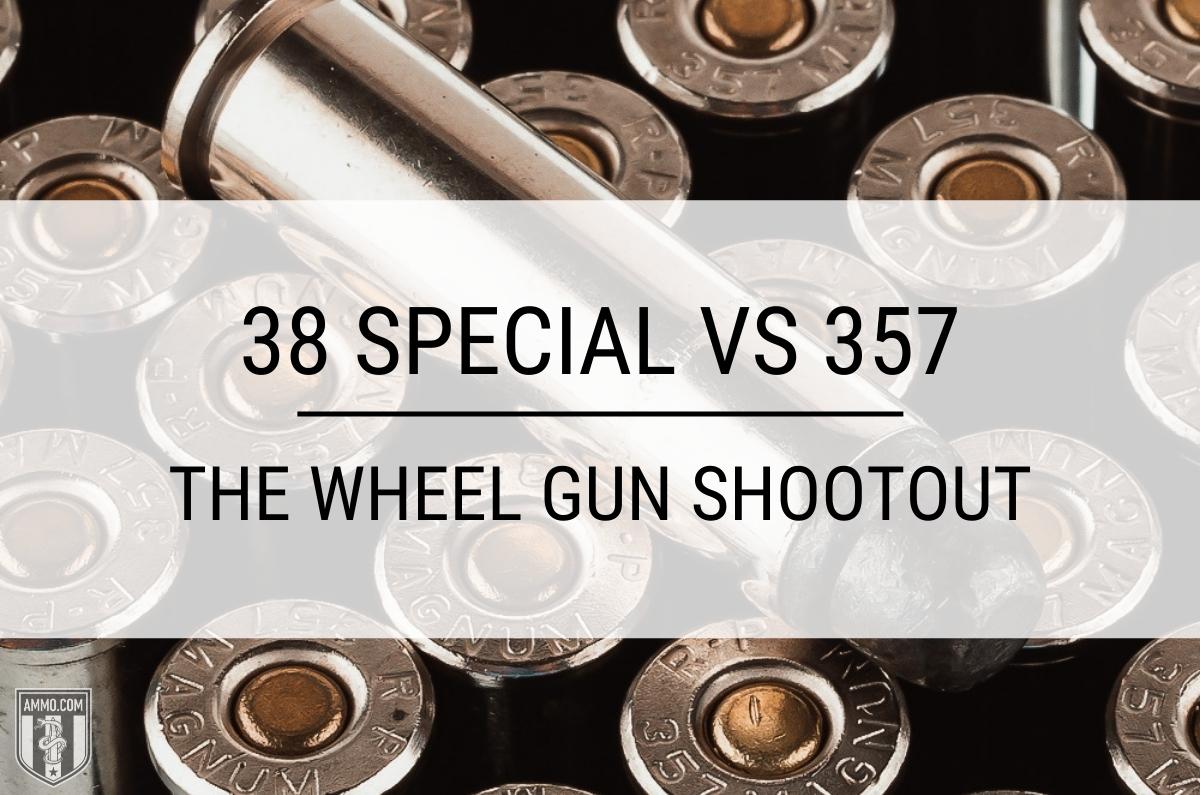 If you quickly glance at 38 Special and 357 Magnum ammo, you might not notice any differences and think they were the same round. Although they are almost identical in their case dimensions, the 38 Special and 357 Magnum are extremely different.
If you quickly glance at 38 Special and 357 Magnum ammo, you might not notice any differences and think they were the same round. Although they are almost identical in their case dimensions, the 38 Special and 357 Magnum are extremely different.
Both revolver rounds are superb choices for concealed carry and self-defense, as they were used by multiple law enforcement agencies well into the 1990s and have proven their efficacy on the streets time and time again.
Let’s take a deeper dive into these two legendary revolver cartridges and discover what’s so great about wheel guns!
What’s the Difference Between 357 and 38?
If you’re familiar with handgun caliber nomenclature, you’d understand that the caliber is often listed in the cartridge name. For example, the 45 ACP fires a 45-caliber bullet while the 40 Smith & Wesson fires a 40-caliber bullet.
This is not the case when it comes to 38 Special and 357 Magnum. You’d think by the name that they fire different caliber bullets, however, they both fire an identical .357” bullet diameter.
The “38” in 38 Special comes from the diameter of the cartridge case, which is .379” wide, while 357 Magnum is named via the standard caliber method.
These two revolver cartridges are identical in their case dimensions except for length, where the 357 Magnum is 1/8 of an inch longer, which brings A LOT of new shooters to the question:
Can a 38 Special revolver shoot 357 Magnum rounds?
NO! You should NEVER shoot a 357 Magnum round out of a 38 Special revolver or carbine.
A 38 Special revolver is NOT rated to handle the higher pressure 357 Magnum loads produce. However, you can safely shoot 38 Special from any 357 Magnum revolver you own since 38 Special loads create considerably less pressure.
Cartridge Specs
Looking at the spec chart, you’ll notice that the 357 Mag and the 38 Special are almost identical except for two major dimensions. The case length of the 357 Magnum is 1/8 of an inch longer and has a maximum pressure that is twice that of 38 Special. This is the reason that you should never fire a 357 Mag out of a 38 Special revolver because the chamber pressure of the 357 can cause a catastrophic failure that could damage the firearm and/or the shooter.
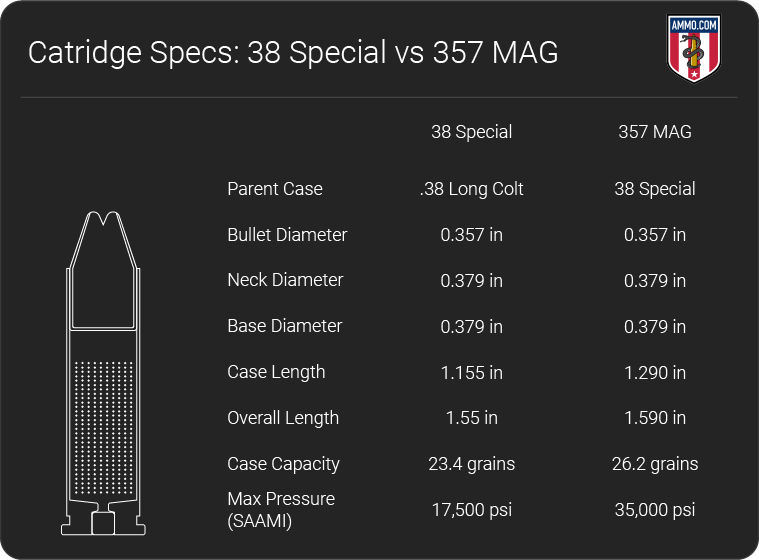
To prevent this from happening, Smith and Wesson elongated the 357 Magnum case so that it would not chamber in a 38 Special cylinder or in a 38 Special lever-action carbine.
As both cartridge headspace off the rim, you can load 38 Special into a 357 Magnum revolver without issue.
Recoil
The amount of recoil a shooter’s wrists will have to endure will be dependent upon several criteria: handgun weight, muzzle velocity (FPS), and bullet weight.
As the 38 Special and 357 Mag fire the same bullet diameter, the bullet weight that each fire will be the same. Handgun weight is up to the personal choice of the shooter, as a lightweight Taurus 856 snubnose will have more felt recoil than a Smith and Wesson Model 629 6-inch barreled steel hunting revolver.
Therefore, the determining factor when it comes to recoil will be the muzzle velocity. And when it comes to being the King of FPS, the 357 Magnum takes the crown.
Modern 357 Magnum ammo is designed to fire a 158-grain bullet at a muzzle velocity of 1,235 FPS and a target thumping 535 ft-lbs of muzzle energy. Compare that to the 38 Special, which fires the same bullet weight at 755 FPS and has a muzzle energy of 200 ft-lbs, which is less than a 45 ACP.
For more ammo options, check out our Remington 357 Magnum ammo page.
The ballistics numbers simply don’t lie, 357 Magnum loads are high velocity and will have considerably more recoil than a 38 Special.
Because of this, many shooters opt to practice using the 38 Special cartridge as it has less recoil and is more comfortable to shoot and load up for personal defense with jacketed hollow point (JHP) 357 magnum rounds.
For more options, check out our Hornady 357 Magnum ammo collection page.
Special Loads
Before we get into the topic of stopping power, it is important to acknowledge the special loads of the 38 Special that have been developed to improve its ballistics and home defense capability. These high-velocity variants were developed to push the limits of the 38 Special cartridge.
38 Special Hi-Speed (.38/44): Developed by Smith & Wesson, the 38 Hi Speed was designed to be fired out of the stronger and larger N-Frame revolver. Only 3 bullet weights were offered: 110 gr, 150 gr, and 158 gr. To compare this to standard 158 grain weight 38 Special, the Hi Speed variant travels at 1,125 FPS, an increase of 370 FPS or almost 50%.
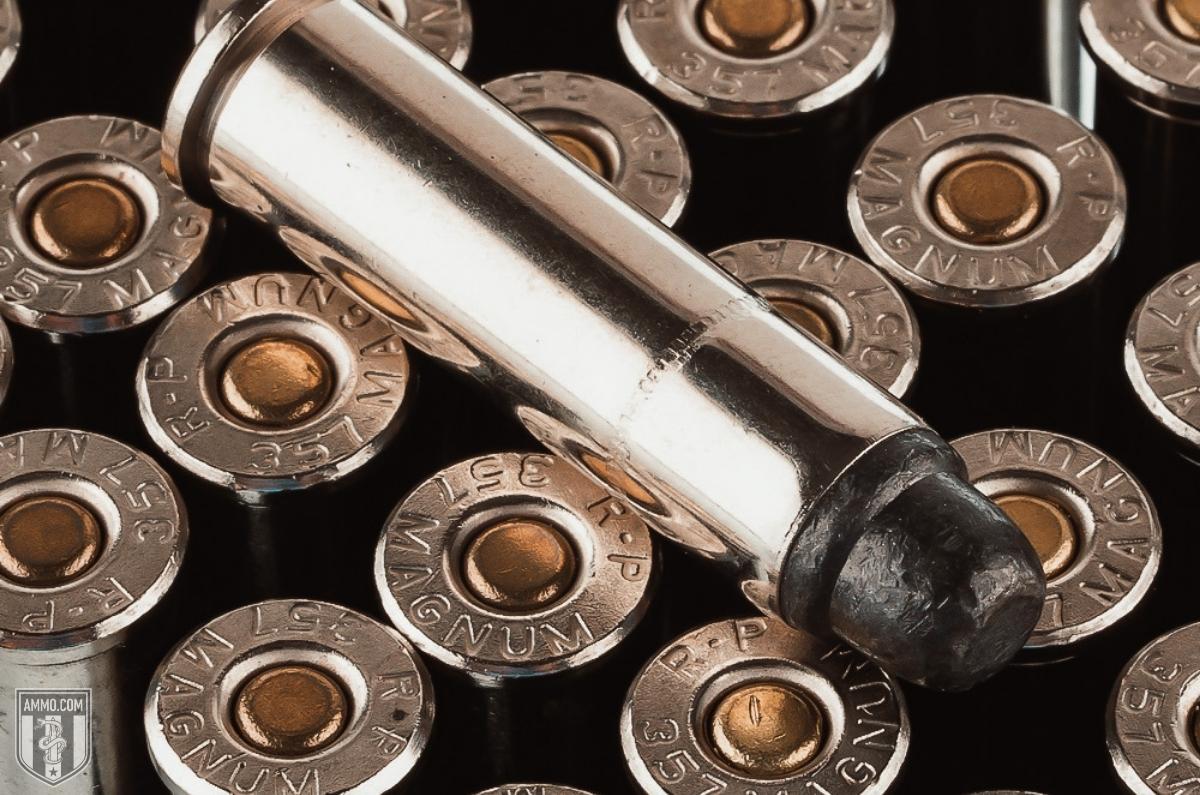
38 Special +P: The 38 Special +P is perhaps the most widely used 38 Special round for self-defense and concealed carry. Developed out of necessity as law enforcement officers in the 1960’s were reporting lackluster terminal performance of standard loads, the 38 Special +P was designed to increase the stopping power of the 38 Special round. The +P designation refers to higher pressure. 38 Special +P is rated at a maximum pressure of 20,000 psi (14% increase) and increases average muzzle velocity to 1,000 FPS (32% increase). This power increase has made self-defense ammunition like Federal Premium 38 Special +P Hydra-Shok JHP much more attractive for CCW permit holders who prefer revolvers.
The FBI Load: The FBI developed its own special version of the 38 Special +P in 1972. This variant utilized a bare lead semi-wadcutter hollow point (LSWCHP) instead of traditional jacketed hollow point ammo. Ballistic gel test results were impressive, and this round was credited with increasing the “one-shot stops” reported by field agents.
38 Special +P+ (AKA the Treasury Load): The Treasury Load was a joint operation between Winchester and Federal to meet the demands of the Treasury Department. The Treasury Department likes to push the limits on handgun cartridges as well as modern monetary theory, as the Treasury Load features a max pressure of 22,500 psi (28% increase over standard) and can push a 110-grain bullet at 1,200 fps from a 4-inch barrel or 1,100 fps from a snubnose with a 2-inch barrel. Don’t even consider using an aluminum or scandium framed revolver for these rounds as a full steel frame is required to handle the higher pressures of +P+ ammo.
Check out Winchester 38 Special ammo for the latest from Winchester!
Stopping Power
Stopping power is always a subjective subject as it cannot be quantified. And if you want to talk about controversy, look no further than firearms forums and do a handgun caliber search. You’ll find proponents of each caliber who are willing to come to digital blows to defend their favorite handgun cartridge.
However, when it comes to 357 Magnum vs 38 Special, the ballistics numbers tell the tale. Although it’s not double, 357 Magnum loads simply outperform 38 Special in every category…and it does so by a country mile.
38 Special +P ammo does help close the gap, but even then, it’s still not even close to coming to the raw, unadulterated power offered by the 357 Mag. The 357 simply has more muzzle velocity, energy, and better terminal ballistics compared to the 38 Special.
Does that mean the 38 Special is ineffective? Definitely not!
As mentioned before, 38 Special +P is an excellent personal defense round and it will stop the bad guy so long as you do your part.
However, the 357 Mag will just do it a bit better, so it gets the nod for stopping power.
Trajectory
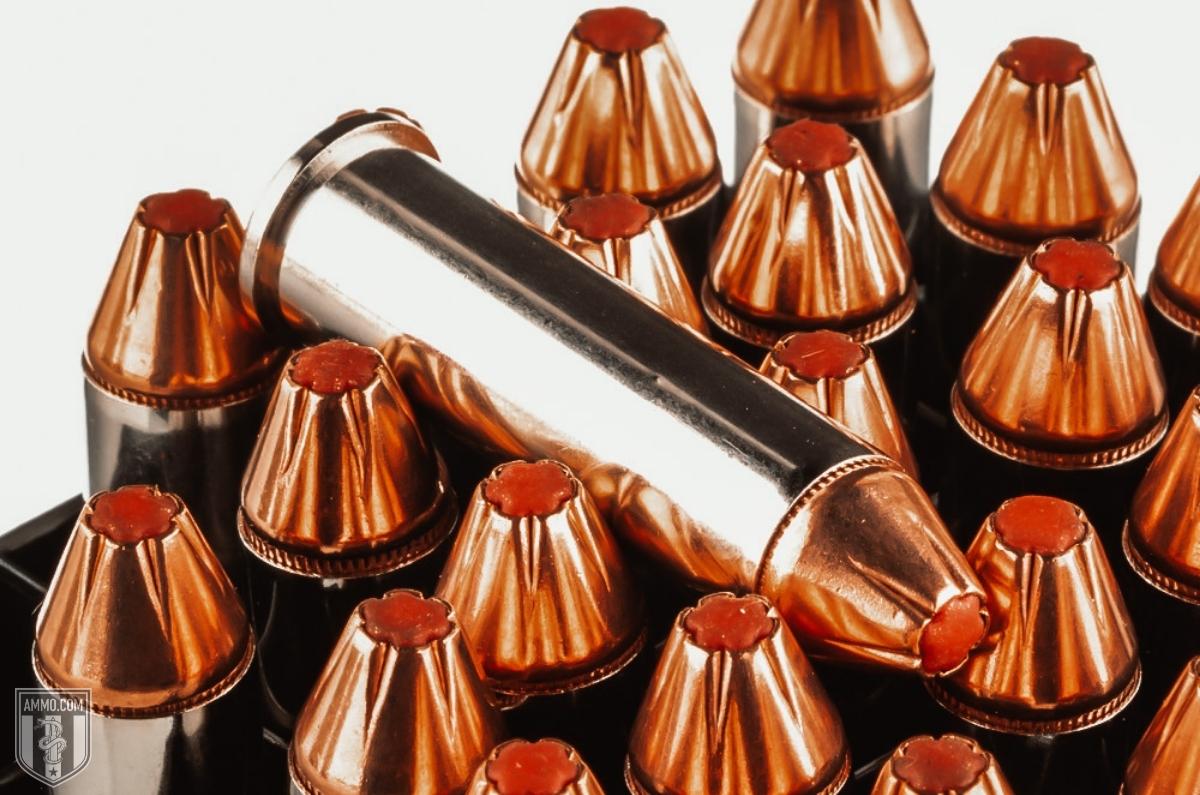
Trajectory is not something that we often discuss when comparing handgun rounds. However, as the 357 Magnum can be used for longer-range shots, it’s something that should be discussed. As the 357 Magnum has higher muzzle velocity, it has a flatter trajectory compared to 38 Special.
The high velocity allows the bullet to reach its target faster, reducing the amount of time gravity has to pull the projectile towards the earth. This makes 357 Magnum a potent hunting round.
Hunting
The 357 Magnum is an extremely capable hunting round, regardless of if it’s fired from a revolver or a rifle.
It is more than powerful enough to take down a whitetail and even a black bear (though I’d prefer a 44 Magnum for this) with proper shot placement and bullet selection. If your state allows it, you can take your 357 Magnum revolver out into the woods for a different kind of whitetail hunt than you’re used to.
As always, do your research on the ideal hunting round as you want excellent penetration and expansion to ensure a clean kill.
Self-Defense and Concealed Carry
In my experience, home defense and concealed carry are two very distinct talking points so we will address them separately.
When it comes to carrying a handgun concealed for personal defense, there are many aspects to consider. Ease of carriage, accuracy, effective terminal ballistics (sorry .22 LR), and reliability. Many shooters will rank those categories in different orders, however, I believe the most important thing you should consider is that you want to have a handgun that you will actually EDC consistently. Herein lies the problem many shooters don't like to discuss: the relationship between handgun weight and ease of concealed carry.
And trust me, I get it.
It sure is comfortable to do some target shooting with your Smith and Wesson 4-inch 686 loaded up with some wadcutter 38 Special ammo. Even shooting 357 Magnum loads out of it is not too oppressive to the wrists, but are you really going EDC a nearly 40 oz stainless steel revolver (that’s heavier than a 1911 if you were wondering)?
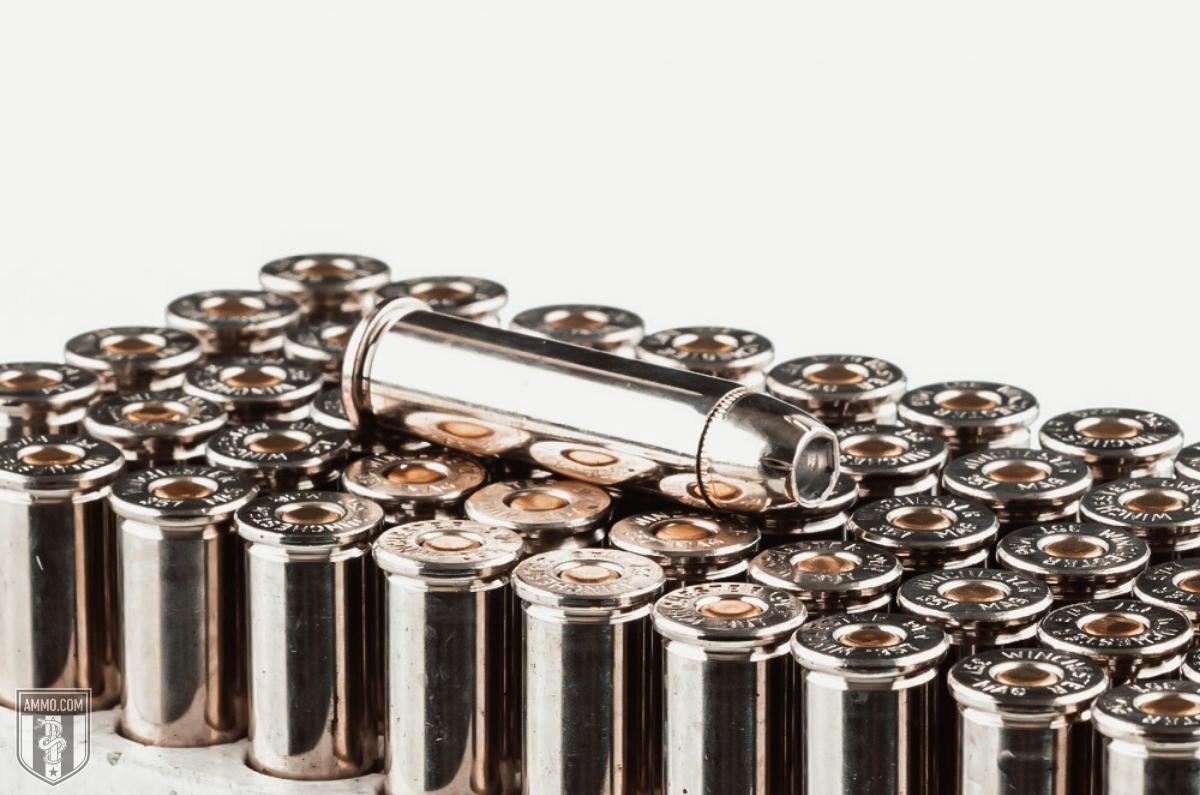
I’m sure there are some hardcore revolver CCW permit holders out there who carry a medium to full-size revolver every day, and to that, I salute you. But it takes a lot of planning in terms of your wardrobe and carry system to handle all that weight and not print when you bend over or sit down.
However, many concealed carry permit holders are going to favor a snubnose revolver over a full size for the ease of carrying a lighter and smaller gun. Your average snubnose runs about 16 oz, about 60% lighter than the Model 686.
But that lightweight build comes with its own tradeoffs, it’s a breeze to carry but the recoil is considerable.
Now, I understand that during a personal defense situation it is unlikely you will care how hard your revolver recoils as the adrenaline dump will numb you to pain. However, you will not have this luxury when you are practicing, and you should ALWAYS shoot at least one cylinder’s worth of your preferred JHP defense round every time you are at the range. Not only does this confirm function, but it prepares you for what it’s like to shoot real magnum loads.
After shooting a cylinder or two of hollow point ammo through your snubnose, many shooters feel that it is not worth the added pain to carry 357 Mag ammo and favor 38 Special +P instead. From a ballistic standpoint, it’s clear that 357 Magnum is superior to 38 Special +P. However, the 38 Special +P round has proven itself to be an effective defense round many times over.
Although I believe the proper choice would be to carry 357 Magnum ammo, if you can’t hit the broadside of a barn due to developing a subconscious trigger jerk from recoil anticipation, then it clearly isn’t the best choice.
The simple answer is that you need to be honest with yourself about your marksmanship skills and trigger discipline when shooting a magnum load vs a 38 +P. If you are more accurate with the +P load and don’t have the confidence in your skills to handle a full power 357 Mag, then carry 38 Special +P confidently and trust that if you do your part, the 38 Special +P will do the rest.
Now home defense is another matter entirely. Unlike concealed carry, handgun weight is simply not a factor to consider. I would suggest that a heavier gun will be more ideal for home defense due to it having less recoil and allowing for faster follow-up shots.
For home defense I thoroughly endorse using a 357 Magnum. Because when my family’s life is threatened, I want as much power as I can handle to stop the threat as quickly as possible.
Some naysayers might contest that the 357 Magnum has a propensity to over-penetrate, and this would be true with lead round nose, FMJ, or semi-wadcutter ammo. However, with premium hollow point ammo such as Winchester PDX1, Remington Golden Saber, or Speer Gold Dots you should not experience overpenetration.
A 38 Special +P is also a fine choice for home defense as its lower recoil will allow for faster follow-up shots, but for me I’m picking the 357 Magnum because I want that raw stopping power in a confined space like a home.
Cost and Availability
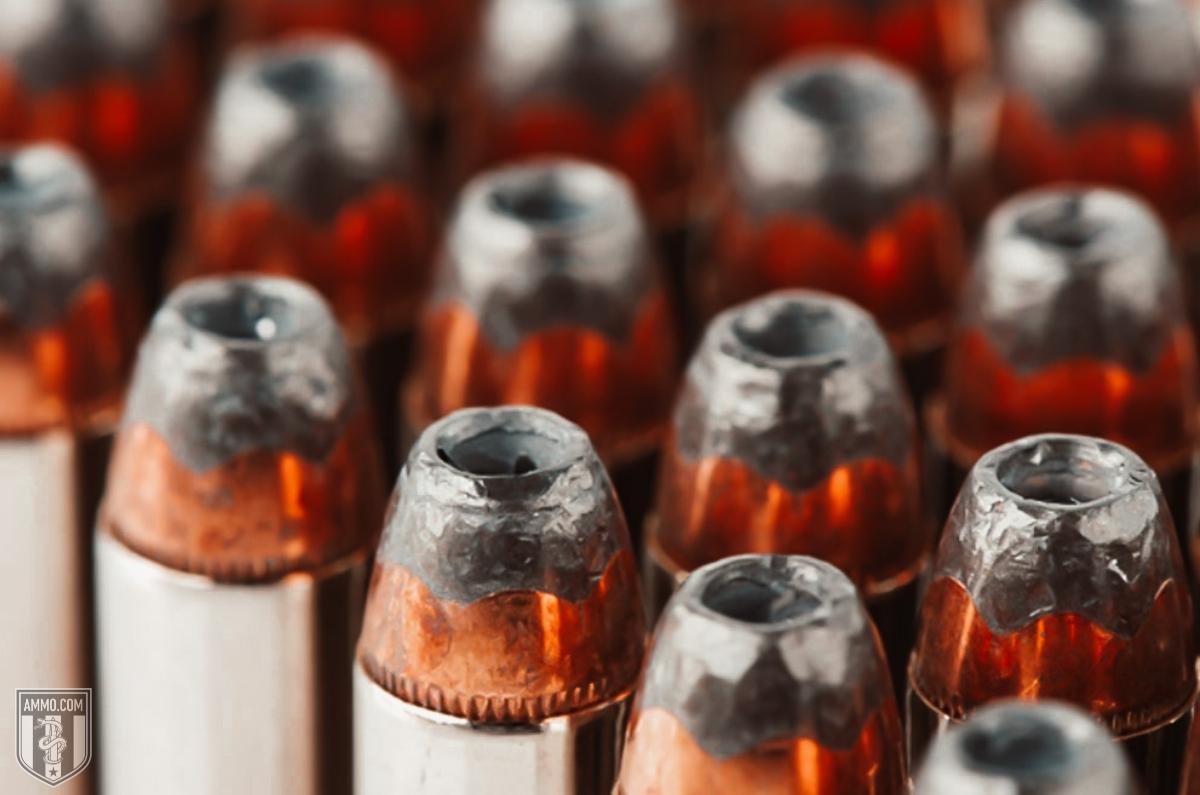
When it comes to price, 38 Special will typically always be less expensive than 357 Mag. This applies to both handguns and ammo.
For 38 Special practice ammo, such as lead round nose or wadcutters, you should expect to pay about $0.60/round while premium hollow point ammo will run around $1.50/round and up at the time of writing. 357 Magnum prices will be about 50-75% higher if not double that of 38 Special.
This trend is consistent with handgun prices as well. Typically, 38 Special revolvers will be about 50% cheaper as they have lighter construction because the 38 is a lower pressure round. In contrast, the high pressure 357 Mag requires rigid construction and a stronger frame to handle the excess pressure and recoil generated by the magnum round.
In terms of availability, any handgun manufacturer which produces revolvers will have offering in both calibers. The 38 Special and 357 Mag are the two most popular revolver calibers and as such, you will not lack for options when it comes to handguns.
Smith and Wesson, Colt, and Ruger are two of the premier revolver manufacturers, and their prices reflect this heritage. For more budget friendly revolvers, you can look to firearm companies like Taurus, EAA, and Charter Arms.
As for ammo, every manufacturer has multiple lines of 38 Special and 357 Magnum. You will not lack for options when it comes to factory loads for either cartridge.
Remember to check out our PMC 38 Special ammo and Fiocchi 38 Special ammo for more ammo options.
Ballistics
Our experts here at Ammo.com have compiled multiple manufacturers ballistic data to share with you here.
As we’ve discussed in the article, the 357 Magnum outperforms the 38 Special in terms of ballistics in every category. However, it does this at the cost of significant recoil and higher pressure.
Let’s look at those ballistic numbers and compare your favorite revolver loads!
38 Special Ballistics
Note: This information comes from the manufacturer and is for informational purposes only. The actual ballistics obtained with your firearm can vary considerably from the advertised ballistics. Also, ballistics can vary from lot to lot with the same brand and type load.
| 38 Special Bullet WEIGHT | Muzzle VELOCITY (fps) | Muzzle ENERGY (ft. lbs.) | Mid-Range TRAJECTORY (in.) | Barrel Length (in.) | |||||
|---|---|---|---|---|---|---|---|---|---|
| Muzzle | 50 yds. | 100 yds. | Muzzle | 50 yds. | 100 yds. | 50 yds. | 100 yds. | ||
| 100 Grain | 950 | 900 | n/a | 200 | 180 | n/a | 1.3 | n/a | 4-V |
| 110 Grain | 945 | 895 | 850 | 220 | 195 | 175 | 1.3 | 5.4 | 4-V |
| 110 Grain JHP | 995 | n/a | n/a | 242 | n/a | n/a | n/a | n/a | n/a |
| 125 Grain JHP | 1000 | n/a | n/a | 278 | n/a | n/a | n/a | n/a | n/a |
| 130 Grain | 775 | 745 | 710 | 175 | 160 | 120 | 1.9 | 7.9 | 4-V |
| 140 Grain Cowboy | 800 | 767 | 735 | 199 | 183 | 168 | n/a | n/a | 7.5-V |
| 140 Grain Multi-Ball | 830 | 730 | 505 | 215 | 130 | 80 | 2 | 10.6 | 4-V |
| 140 Grain JHP | 950 | n/a | n/a | 281 | n/a | n/a | n/a | n/a | n/a |
| 148 Grain | 710 | 635 | 565 | 165 | 130 | 105 | 2.4 | 10.6 | 4-V |
| 158 Grain | 755 | 725 | 690 | 200 | 185 | 170 | 2 | 8.3 | 4-V |
| 158 Grain JHP | 900 | n/a | n/a | 284 | n/a | n/a | n/a | n/a | n/a |
| 95 Grain +P | 1175 | 1045 | 960 | 290 | 230 | 195 | 0.9 | 3.9 | 4-V |
| 110 Grain +P | 995 | 925 | 870 | 240 | 210 | 185 | 1.2 | 5.1 | 4-V |
| 125 Grain +P | 945 | 900 | 860 | 250 | 225 | 205 | 1.3 | 5.4 | 4-V |
| 125 Grain +P | 975 | 929 | 885 | 264 | 238 | 218 | 1 | 5.2 | 4" |
| 129 Grain +P | 945 | 910 | 870 | 255 | 235 | 215 | 1.3 | 5.3 | 4-V |
| 130 Grain +P | 925 | 887 | 852 | 247 | 227 | 210 | 1.3 | 5.5 | 4-V |
| 147 Grain +P | 884 | n/a | n/a | 264 | n/a | n/a | n/a | n/a | 4-V |
| 150 Grain +P | 884 | n/a | n/a | 264 | n/a | n/a | n/a | n/a | 4-V |
| 158 Grain +P | 890 | 855 | 825 | 280 | 255 | 240 | 1.4 | 6 | 4-V |
357 Magnum Ballistics
Note: This information comes from the manufacturer and is for informational purposes only. The actual ballistics obtained with your firearm can vary considerably from the advertised ballistics. Also, ballistics can vary from lot to lot with the same brand and type load.
| 357 Sig Bullet WEIGHT | Muzzle VELOCITY (fps) | Muzzle ENERGY (ft. lbs.) | Mid-Range TRAJECTORY (in.) | Barrel Length (in.) | |||||
|---|---|---|---|---|---|---|---|---|---|
| Muzzle | 50 yds. | 100 yds. | Muzzle | 50 yds. | 100 yds. | 50 yds. | 100 yds. | ||
| 115 Grain | 1520 | n/a | n/a | 593 | n/a | n/a | n/a | n/a | n/a |
| 124 Grain | 1450 | n/a | n/a | 578 | n/a | n/a | n/a | n/a | n/a |
| 125 Grain | 1350 | 1190 | 1080 | 510 | 395 | 325 | 0.7 | 3.1 | 4" |
| 135 Grain | 1225 | 1112 | 1031 | 450 | 371 | 319 | n/a | n/a | 4" |
| 147 Grain | 1225 | 1132 | 1060 | 490 | 418 | 367 | n/a | n/a | 4" |
| 150 Grain | 1130 | 1030 | 970 | 420 | 355 | 310 | 0.9 | 4 | n/a |
History of the 38 Special
As with many advancements in cartridge technology, the 38 Special cartridge was developed out of necessity.
In 1897, the American forces involved the Spanish-American War and subsequent Philippine-American War discovered that their 38 Long Colt revolvers were ineffective against the Philippine Moro warriors. The 38 Long Colt lacked the power to penetrate the hardened wood shields wielded by the Moro soldiers, and an order was sent to Smith & Wesson to develop a new, more powerful revolver cartridge.
Using the 38 Long Colt as the parent case, in 1898 Smith and Wesson introduced their new cartridge: the 38 Special. The 38 Special is also known as the 38 S&W Special, 38 Smith & Wesson Special, 38 Spl, 38 Spc, and internationally as 9x29mmR.
The 38 Spl is a rimmed, straight wall, centerfire handgun cartridge that was developed for high velocity (at the time) for increased penetration and stopping power. The original design utilized black powder as the propellant. However, within a year of introduction, manufacturers switched to smokeless powder.
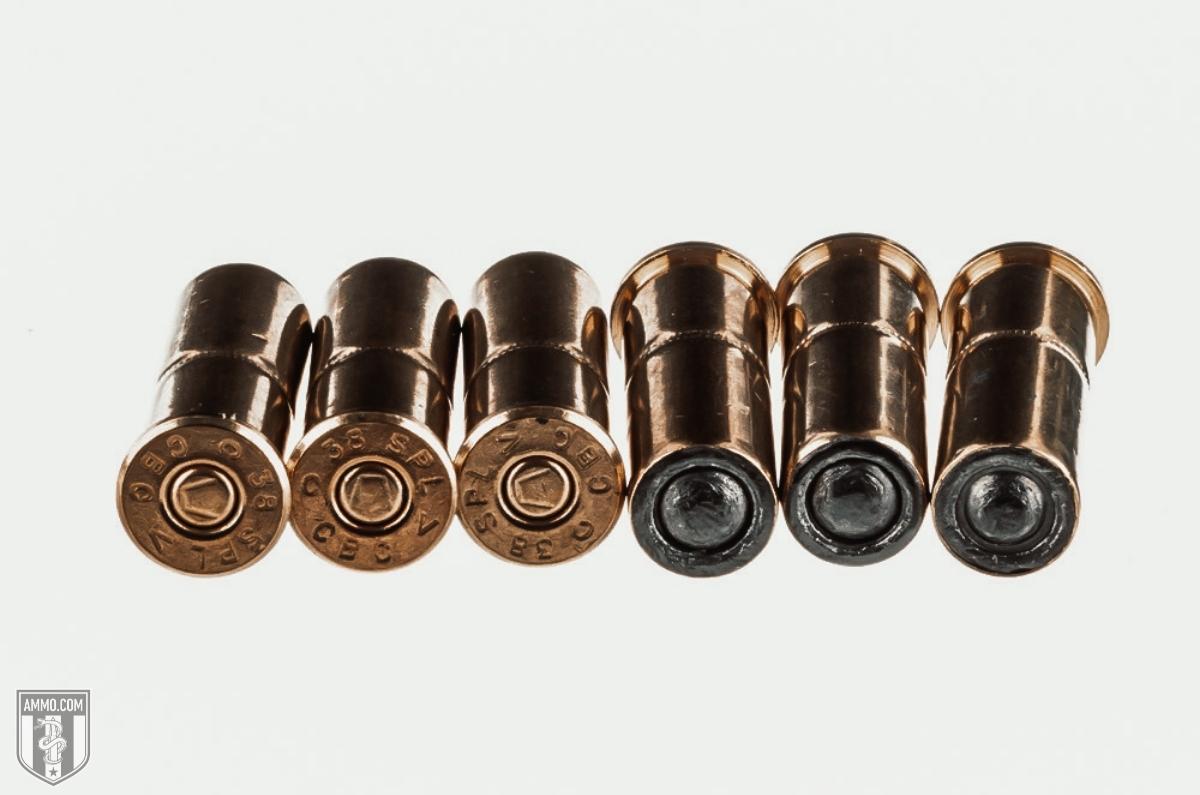
The original 38 Special round was loaded with 21 grains of black powder (3 gr more than its predecessor) and offered a 100-150 FPS increase in muzzle velocity over the 38 Long Colt, giving soldiers the penetration needed from their Smith and Wesson M&P revolvers.
Since its introduction, the 38 Special has remained the most popular revolver cartridge around the world. Although the 38 Special was not the primary US sidearm cartridge for a long time, being replaced by the 45 ACP, the 38 Spl was issued to multiple military personnel during both World Wars, Korea, and Vietnam.
The 38 Spl was the standard issue sidearm cartridge for the majority of law enforcement departments in the US from the 1920s all the way into the 1990s.
Although the 38 Special is no longer in service for the military or police, it is still favored by numerous recreational and competitive shooters around the world. With its low recoil and versatility of bullet choices, the 38 Special is an ideal choice for target shooting, USPSA competition, and Cowboy Action shooting.
The switch to smokeless powder early in the 38 Special’s life meant that there was a lot of unused space inside the cartridge, as smokeless powder requires less volume to achieve appropriate pressures. As a consequence, many reloaders and wildcatters would often push the limits of the 38 Special to see what they could come up with.
Once such reloader was Elmer Keith, who developed the famed 357 Magnum from the 38 Special.
History of the 357 Magnum
Regarded as the Father of the Modern Magnum, Elmer Keith is credited with the development of the 357 Magnum, and later the 44 Magnum and the 41 Magnum.
Keith, in conjunction with Phillip Sharpe, worked on increasing the power of the 38 Special by dosing it with a bit more powder. To accommodate the increased powder charge, the 38 Special case was elongated by about 0.15”, preventing it from chambering in a 38 Special revolver.
The resulting cartridge was submitted to Smith and Wesson in 1934, and thus the 357 Magnum was born.
The new cartridge was primarily marketed to law enforcement who needed a more powerful handgun round to combat bootleggers and the mafia. Criminals of the Prohibition Era were wearing early ballistic vests and using cars for cover, and the 38 Special was simply not enough to defeat these defenses. However, the new 357 Magnum offered the penetration police needed to defeat these threats.
Seeing its effectiveness, almost every police department across the United States switched to the 357 Magnum until the onset of the reliable polymer-framed semi-automatic handguns in the 1990s. In the civilian market, the 357 has remained popular for self-defense and target shooting. It has also established itself as a viable hunting round for whitetail and black bear with proper loadings.

Final Shots: 357 Magnum vs 38 Special
When it comes to personal defense, it is hard to beat the 38 Special or 357 Magnum. 38 Special ammo, especially the +P variety, is well known for its low recoil and has a distinguished track record as being a superb self-defense round. Revolvers chambered in 38 Special are relatively inexpensive and ammo is plentiful in a variety of loadings to suit your shooting needs.
But if you want pure strength and power, the high velocity and higher pressure 357 Magnum is the handgun caliber for you. Known for its incredible stopping power, the 357 Magnum has proven to be a potent personal defense round that can handle most any two or four-legged threat you might encounter in the wild. However, all this power comes at the cost of considerably higher recoil and monetary cost to the shooter.
Understanding what you can handle in your EDC handgun is a deeply personal decision and one that you need to be honest with yourself about. You should not feel under gunned if you opt for 38 Special +P nor should you feel obligated to carry 357 Magnum if you don’t feel you can handle the higher pressure and recoil.
Purchasing a 357 Magnum revolver offers shooters the most versatility, as you can shoot both 357 Mag and 38 Spl from it. However, if you purchase a revolver chambered in 38 Special +P, you are limited to that ammo type as it cannot handle the higher pressure of the 357 Magnum.
When it comes to picking a handgun caliber, knowing what you shoot best is the most important aspect of the choice. Therefore, it’s high time you got out to the range and found out, as neither the 38 Special nor the 357 Magnum will let you down in any self-defense situation.
Ammo Comparisons
- .308 vs 5.56
- 6.5 Creedmoor vs .308
- .300 Blackout vs .308
- .300 Win Mag vs .308
- .243 vs .308
- .308 vs .30-06
- 7mm-08 vs .308
- .270 vs .308
- 7.62x39 vs .308
- .223 vs .308
- .338 Lapua vs .308
- .380 ACP vs 9mm
- .223 vs 5.56
- .300 Blackout vs 5.56
- 9mm vs 45 ACP
- 9mm vs 40 S&W
- .357 SIG vs 9mm
- 10mm vs 9mm
- 9mm vs 9mm Luger
- .243 vs .270
- .300 Win Mag vs .30-06
- .270 vs .30-06
- .40 vs .45
- 38 Special vs 357
- 9mm vs 40 vs 45
- 5.56 vs 7.62x39
- 338 Lapua vs .30-06
- .30-30 vs .30-06
- 300 PRC vs 338 Lapua
- .30-06 vs 7mm
- 300 Win Mag vs 338 Lapua
- 300 PRC vs 300 Win Mag
- 300 WSM vs 300 Win Mag
- 338 Win Mag vs 338 Lapua
- 12 Gauge vs 20 Gauge
- 10mm vs 357 Mag
- .30-30 vs 7.62x39
- 224 Valkyrie vs 22-250
- 17 HMR vs 22 Mag
- 7.62x39 vs .300 Blackout
- 45 ACP vs 45 Auto
- 45-70 vs 30-30
- 300 Blackout vs 223
- 357 Magnum vs 9mm
- 350 Legend vs 300 Blackout
- 224 Valkyrie vs 223
- 45 ACP vs 38 Super
- 6.5 Grendel vs .308
- 17 HMR vs 22 LR
- 10 Gauge vs 12 Gauge
- 22-250 vs 223
- 45 Colt vs 45 ACP
- 350 Legend vs 30-30
- 5.7x28 vs 223
- 5.7 vs 9mm
- 5.56 vs 5.7
- 22 vs 9mm
- Buckshot vs Birdshot
- 450 Bushmaster vs 308
- 450 Bushmaster vs 223
- Buckshot vs Slug
- 6.5 Grendel vs 5.56 vs 223
- 6mm ARC vs 6.5 Grendel
- 44 vs 45
- 458 SOCOM vs 5.56
- 357 vs 44
- 32 ACP vs 380
- 300 Win Mag vs 338 Win Mag vs 338 Lapua Mag
- 450 Bushmaster vs 458 SOCOM vs 50 Beowulf
- 6mm Creedmoor vs 6.5 Creedmoor
- TMJ vs FMJ
- 44 Special Vs 44 Magnum
- 45 90 vs 45 70
- 6.8 Western vs 6.8 SPC
- 50 Beowulf vs 50 BMG
- 26 Nosler vs 6.5 PRC
- 28 Gauge vs 410
- 6.8 SPC vs 5.56
- 6.8 SPC vs 6.5 Grendel
- 6.8 Western vs 7mm Rem Mag vs .28 Nosler
- 6.8 Western vs 6.5 Creedmoor
- 22 Hornet vs 223
- 6.8 Western vs 6.5 PRC
- .410 vs 12 Gauge
- .410 vs 20 Gauge
- 22 LR vs 22 Mag
- 6mm ARC vs 243
- 7mm-08 vs 270
- 243 vs 6.5 Creedmoor
- Nickel vs Brass Casing
- 204 Ruger vs 223
- 50 Beowulf vs 5.56
- 260 Remington vs 6.5 Creedmoor
- 6mm Remington vs 243
- 28 Nosler vs 300 PRC
- 50 Beowulf vs 50 AE
- 22 Nosler vs 22-250
- 450 Marlin vs 45-70
- 300 Win Mag vs 300 Norma
- 458 SOCOM vs 300 Blackout
- 38-55 vs 45-70
- 22 Hornet vs 22 LR
- 300 Norma vs 338 Lapua
- 338 Lapua vs 50 BMG
- 28 Nosler vs 300 Win Mag
- 28 Nosler vs 6.5 Creedmoor
- 204 vs 22-250
- 458 SOCOM vs 45 70
- 44 40 vs 45 70
- 6.8 SPC vs 6.5 Creedmoor
- 450 Bushmaster vs 30-06
- 7mm Rem Mag vs 300 Win Mag
- 30 Carbine vs 223
- 25-06 vs 30-06
- 26 Nosler vs 28 Nosler
- 16ga vs 12ga
- 30 06 vs 7.62 x54R
- 9mm Makarov vs 9mm Luger
- 350 Legend vs 223
- 30 Carbine vs 5.56
- 6.5x55 vs 6.5 Creedmoor
- 6.5 Creedmoor vs 270 vs 25-06
- M193 vs M855
- 450 Bushmaster vs 458 SOCOM
- 6.5 Grendel vs 6.5 Creedmoor
- 350 Legend vs 5.56
- .277 Fury vs 6.8 SPC
- 277 Fury vs 300 Win Mag
- 10mm vs .45 ACP
- 277 Fury vs 223
- 6.8 SPC vs 300 Blackout
- 6.5 PRC vs 6.5 Creedmoor
- 277 Fury vs 308
- 277 Fury vs 6.5 Creedmoor
- 350 Legend vs 450 Bushmaster
- 277 Fury Vs 5.56 NATO
- 10mm vs 40S&W
- 32 ACP vs 9mm
- 32 Special vs 9mm
- 8.6 Blackout vs 300 Blackout
- 30 Super Carry vs. 9mm
- 5.56 vs 9mm
- .50 Action Express vs 9mm
- 7.62x25 vs. 9mm
- 10mm vs 44 Magnum
- 300 Blackout vs 300 Win Mag
- 6.5 Grendel vs 300 Blackout
- 460 Rowland vs 10mm
- 300 RUM vs 300 PRC
- 300 Norma vs 300 PRC
- 45 GAP vs 45 ACP
- 7mm PRC vs 300 Win Mag
- 300 PRC vs 6.5 Creedmoor
- 300 PRC vs 308
- 357 SIG vs 357 Mag
- 7.62x39 vs 7.62x51
- 243 Win vs 223 Rem
- 30 Nosler vs 300 PRC
- 6.5 Creedmoor vs. 30-06 Springfield
- 450 S&W vs. 44 Magnum
- 6.5 Creedmoor vs. 300 Win Mag
- 454 Cassull vs. 45-70 Govt
- 454 Cassull vs. 44 Mag
- 7.62x54r vs. 308 Winchester
- 22 ARC vs. 223 Rem
- Subsonic vs. Supersonic Ammo
